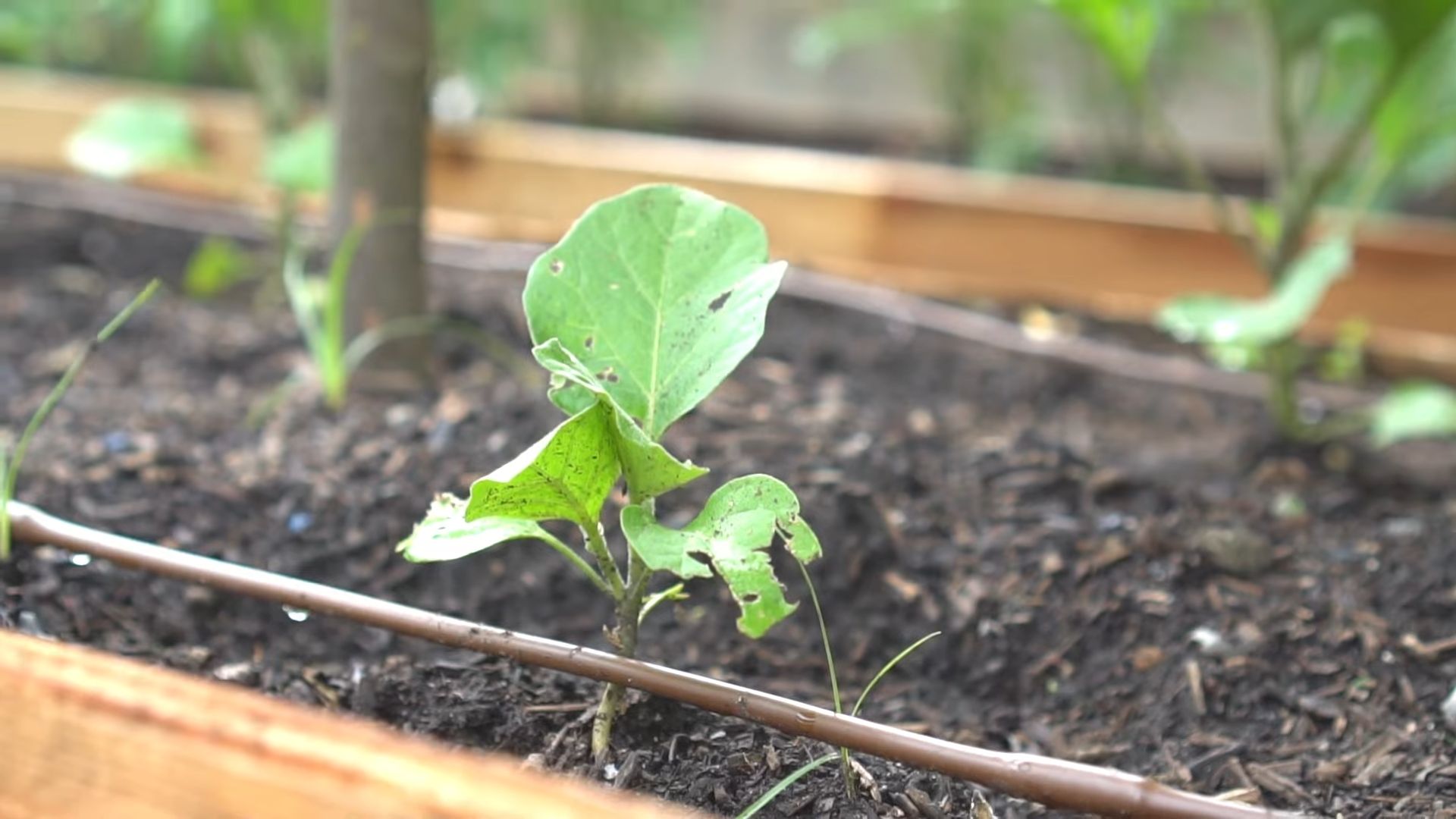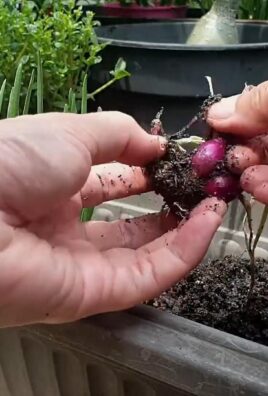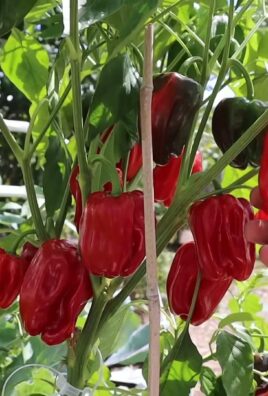Growing eggplant backyard can seem daunting, right? I totally get it! You see those glossy, vibrant eggplants at the farmer’s market and think, “Wow, I wish I could do that!” Well, guess what? You absolutely can! This isn’t just about having fresh veggies; it’s about connecting with nature, enjoying the satisfaction of nurturing life, and knowing exactly where your food comes from.
Eggplant, with its rich history tracing back to ancient Asia, has been cultivated for centuries. It wasn’t always the culinary star it is today; in some cultures, it was initially grown for ornamental purposes! Now, it’s a staple in cuisines worldwide, from Italian eggplant parmesan to Indian baingan bharta. But why rely solely on the store when you can have your own thriving eggplant patch just steps away?
In today’s world, where we’re increasingly conscious of food miles and the impact of our choices, growing eggplant backyard offers a sustainable and rewarding alternative. Plus, let’s be honest, store-bought eggplants often lack the flavor and freshness of homegrown ones. This DIY guide is packed with simple tricks and hacks to help you cultivate a bountiful eggplant harvest, even if you’re a complete beginner. I’m going to share my secrets to avoid common pitfalls, maximize your yield, and enjoy delicious, homegrown eggplants all season long. So, grab your gardening gloves, and let’s get started!

Growing Eggplant Like a Pro: My Backyard Guide
Hey there, fellow gardening enthusiasts! I’m so excited to share my tried-and-true method for growing plump, juicy eggplants right in your own backyard. Forget those bland, store-bought veggies – homegrown eggplant is bursting with flavor and so rewarding to cultivate. This guide is packed with everything I’ve learned over the years, from seed starting to harvesting, so you can enjoy a bountiful eggplant harvest. Let’s get our hands dirty!
Choosing the Right Eggplant Variety
Before we dive into the nitty-gritty, let’s talk varieties. Eggplants come in all shapes, sizes, and colors, so choosing the right one for your climate and preferences is key. Here are a few of my favorites:
* Black Beauty: This is a classic for a reason! It produces large, dark purple fruits and is relatively easy to grow.
* Ichiban: If you’re looking for something a little different, try Ichiban. It yields long, slender, dark purple eggplants with a delicate flavor.
* Fairy Tale: These adorable, miniature eggplants are perfect for containers and have a mild, sweet taste.
* Rosa Bianca: For a beautiful and delicious option, go for Rosa Bianca. Its lavender and white striped fruits are stunning and have a creamy texture.
* Japanese Eggplant: These are long and thin, with a very dark purple, almost black, skin. They are great for stir-fries.
Consider your local climate and growing season when making your choice. Some varieties are more heat-tolerant than others, so do your research!
Starting Eggplant Seeds Indoors
Eggplants need a long growing season, so starting seeds indoors is essential, especially if you live in a cooler climate. I usually start my seeds about 8-10 weeks before the last expected frost.
What You’ll Need:
* Eggplant seeds
* Seed starting trays or small pots
* Seed starting mix
* Spray bottle
* Heat mat (optional, but helpful)
* Grow lights (essential)
Step-by-Step Instructions:
1. Prepare the Seed Starting Trays: Fill your seed starting trays or pots with seed starting mix. Gently tap the trays to settle the soil.
2. Sow the Seeds: Make a small indentation (about ¼ inch deep) in each cell or pot. Place 2-3 seeds in each indentation. This increases the chances of at least one seed germinating.
3. Cover the Seeds: Gently cover the seeds with a thin layer of seed starting mix.
4. Water the Seeds: Use a spray bottle to moisten the soil. Avoid overwatering, as this can lead to damping off (a fungal disease that kills seedlings).
5. Provide Warmth: Place the seed starting trays on a heat mat (if using) and cover them with a humidity dome or plastic wrap. This will help to create a warm, humid environment that encourages germination.
6. Provide Light: Place the trays under grow lights. Eggplant seedlings need plenty of light to grow strong and healthy. Position the lights a few inches above the trays and keep them on for 14-16 hours per day.
7. Monitor and Water: Check the soil moisture daily. Keep the soil consistently moist, but not soggy. Water as needed with a spray bottle.
8. Remove Humidity Dome: Once the seeds have germinated (usually within 7-14 days), remove the humidity dome or plastic wrap.
9. Thin Seedlings: Once the seedlings have developed their first true leaves (the leaves that appear after the initial seed leaves), thin them to one seedling per cell or pot. Choose the strongest, healthiest seedling and snip off the others at the soil line.
10. Harden Off Seedlings: About a week before you plan to transplant the seedlings outdoors, begin hardening them off. This process gradually acclimates the seedlings to outdoor conditions. Start by placing the trays outdoors in a sheltered location for a few hours each day, gradually increasing the amount of time they spend outside. Protect them from direct sunlight and strong winds.
Preparing the Garden Bed
Eggplants need a sunny spot with well-drained soil. I always amend my soil with plenty of compost to improve drainage and fertility.
What You’ll Need:
* Garden fork or tiller
* Compost
* Balanced fertilizer (e.g., 10-10-10)
* Measuring tape
* Garden stakes (optional)
* Row covers (optional, for early season protection)
Step-by-Step Instructions:
1. Choose a Sunny Location: Select a spot in your garden that receives at least 6-8 hours of direct sunlight per day.
2. Prepare the Soil: Use a garden fork or tiller to loosen the soil to a depth of at least 12 inches. Remove any rocks, weeds, or debris.
3. Amend the Soil: Spread a 2-3 inch layer of compost over the soil. Compost is like magic for your garden! It improves drainage, adds nutrients, and helps retain moisture.
4. Incorporate Fertilizer: Apply a balanced fertilizer (e.g., 10-10-10) according to the package directions. This will provide the eggplants with the nutrients they need to grow strong and produce lots of fruit.
5. Create Planting Holes: Space the planting holes about 24-36 inches apart, depending on the variety of eggplant you are growing. Refer to the seed packet or plant tag for specific spacing recommendations.
6. Optional: Install Stakes: If you are growing a tall or heavy-fruiting variety of eggplant, consider installing stakes near each planting hole. This will provide support for the plants as they grow and prevent them from falling over.
7. Optional: Prepare Row Covers: If you are transplanting your seedlings outdoors early in the season, you may want to use row covers to protect them from frost and cold temperatures.
Transplanting Eggplant Seedlings Outdoors
Once the danger of frost has passed and the soil has warmed up, it’s time to transplant your eggplant seedlings outdoors.
What You’ll Need:
* Hardened-off eggplant seedlings
* Trowel
* Watering can or hose
* Mulch (e.g., straw, wood chips)
Step-by-Step Instructions:
1. Water the Seedlings: Water the eggplant seedlings thoroughly before transplanting them. This will help to reduce transplant shock.
2. Carefully Remove Seedlings: Gently remove the seedlings from their trays or pots. Be careful not to damage the roots.
3. Plant the Seedlings: Place each seedling in a planting hole, making sure that the top of the root ball is level with the surrounding soil.
4. Fill the Holes: Fill the holes with soil and gently firm the soil around the base of the plants.
5. Water Thoroughly: Water the newly transplanted seedlings thoroughly.
6. Apply Mulch: Apply a 2-3 inch layer of mulch around the base of the plants. Mulch helps to retain moisture, suppress weeds, and regulate soil temperature.
Caring for Your Eggplant Plants
Eggplants need consistent watering, regular fertilization, and protection from pests and diseases.
Watering:
* Water deeply and regularly, especially during hot, dry weather. Aim for about 1-2 inches of water per week.
* Water at the base of the plants to avoid wetting the foliage, which can lead to fungal diseases.
* Use a soaker hose or drip irrigation system to deliver water directly to the roots.
Fertilizing:
* Fertilize every 2-3 weeks with a balanced fertilizer or a fertilizer specifically formulated for vegetables.
* Follow the package directions carefully to avoid over-fertilizing.
* Side-dress the plants with compost or aged manure to provide a slow-release source of nutrients.
Pest and Disease Control:
* Flea Beetles: These tiny beetles can chew holes in the leaves of eggplant seedlings. Cover the seedlings with row covers to protect them. You can also use insecticidal soap or neem oil to control flea beetles.
* Aphids: These small, sap-sucking insects can weaken eggplant plants. Spray the plants with a strong stream of water to dislodge aphids. You can also use insecticidal soap or neem oil.
* Tomato Hornworms: These large caterpillars can quickly defoliate eggplant plants. Handpick them off the plants and drop them into a bucket of soapy water.
* Verticillium Wilt: This fungal disease can cause eggplant plants to wilt and die. Choose disease-resistant varieties and practice crop rotation to prevent verticillium wilt.
* Blossom-End Rot: This condition causes the bottom of the eggplant fruit to rot. It is usually caused by calcium deficiency or inconsistent watering.

Conclusion
So, there you have it! Mastering the art of growing eggplant in your backyard is not only achievable but also incredibly rewarding. We’ve walked you through the essential steps, from selecting the right variety and preparing your soil to nurturing your plants and harvesting your delicious bounty. But why is this DIY approach a must-try?
Firstly, consider the unparalleled freshness and flavor. Store-bought eggplants simply can’t compare to the vibrant taste of a homegrown, sun-ripened fruit. You control every aspect of its growth, ensuring it’s free from unwanted pesticides and packed with nutrients. Secondly, think about the cost savings. Over time, growing your own eggplant can significantly reduce your grocery bill, especially if you’re a frequent eggplant consumer. And finally, there’s the sheer satisfaction of nurturing a plant from seed to table. It’s a truly fulfilling experience that connects you with nature and provides a sense of accomplishment.
But the journey doesn’t end here! Feel free to experiment with different eggplant varieties to discover your personal favorites. Try growing classic Italian eggplants like ‘Black Beauty’ for traditional dishes, or venture into the exotic with Thai green eggplants for curries and stir-fries. You can also explore different growing methods, such as container gardening for smaller spaces or raised beds for improved drainage.
Consider companion planting to further enhance your eggplant’s growth. Basil, thyme, and marigolds are excellent choices, as they deter pests and attract beneficial insects. You can also try intercropping with leafy greens like lettuce or spinach to maximize your garden space.
Don’t be afraid to get creative with your eggplant recipes, too! Beyond the classic eggplant parmesan, explore dishes like baba ghanoush, ratatouille, or even grilled eggplant steaks. The possibilities are endless!
We understand that growing eggplant can sometimes present challenges, but with a little patience and attention, you can overcome any obstacles. Remember to monitor your plants regularly for pests and diseases, and adjust your watering and fertilizing schedule as needed.
Growing eggplant in your backyard is an investment in your health, your wallet, and your overall well-being. It’s a chance to connect with nature, learn new skills, and enjoy the delicious fruits (or rather, vegetables!) of your labor.
So, what are you waiting for? Grab your seeds, prepare your soil, and embark on this exciting gardening adventure. We’re confident that you’ll be amazed by the results.
We encourage you to try this DIY trick and share your experiences with us! Post photos of your eggplant harvests, share your favorite recipes, and let us know what challenges you faced and how you overcame them. Together, we can create a thriving community of eggplant enthusiasts and inspire others to embrace the joys of homegrown produce. Happy gardening!
Frequently Asked Questions (FAQ)
What is the best time to start growing eggplant?
The best time to start growing eggplant depends on your climate. Eggplants are warm-weather crops and require a long growing season of at least 70-85 days. In colder climates, it’s best to start seeds indoors 6-8 weeks before the last expected frost. In warmer climates, you can direct sow seeds outdoors after the danger of frost has passed and the soil has warmed up to at least 70°F (21°C).
What kind of soil is best for growing eggplant?
Eggplants thrive in well-drained, fertile soil that is rich in organic matter. The ideal soil pH is between 6.0 and 6.8. Before planting, amend your soil with compost, aged manure, or other organic materials to improve its drainage, fertility, and water-holding capacity. Avoid heavy clay soils, as they can become waterlogged and hinder root growth.
How much sunlight do eggplants need?
Eggplants require at least 6-8 hours of direct sunlight per day to produce a bountiful harvest. Choose a planting location that receives full sun throughout the day. If you live in a particularly hot climate, some afternoon shade may be beneficial to prevent the plants from overheating.
How often should I water my eggplants?
Eggplants need consistent moisture to thrive. Water deeply and regularly, especially during hot, dry weather. Aim to keep the soil consistently moist but not waterlogged. A good rule of thumb is to water when the top inch of soil feels dry to the touch. Mulching around the plants can help retain moisture and suppress weeds.
What are some common pests and diseases that affect eggplants?
Eggplants are susceptible to a variety of pests and diseases, including aphids, flea beetles, spider mites, tomato hornworms, and verticillium wilt. Regularly inspect your plants for signs of infestation or disease. Use organic pest control methods, such as insecticidal soap or neem oil, to control pests. Choose disease-resistant varieties and practice crop rotation to prevent diseases.
How do I fertilize my eggplants?
Eggplants are heavy feeders and require regular fertilization to produce a good harvest. Apply a balanced fertilizer (e.g., 10-10-10) at planting time and then side-dress with a nitrogen-rich fertilizer every 2-3 weeks during the growing season. You can also use organic fertilizers, such as compost tea or fish emulsion.
When and how do I harvest eggplants?
Eggplants are typically ready to harvest 70-85 days after transplanting. The fruit should be firm, glossy, and have a deep, rich color. Gently twist or cut the eggplant from the plant, leaving a small piece of the stem attached. Overripe eggplants will become dull, soft, and bitter.
Can I grow eggplants in containers?
Yes, eggplants can be successfully grown in containers, especially if you have limited garden space. Choose a large container (at least 5 gallons) with drainage holes. Use a high-quality potting mix and follow the same watering and fertilizing guidelines as for in-ground plants. Container-grown eggplants may require more frequent watering and fertilization.
What are some good companion plants for eggplants?
Good companion plants for eggplants include basil, thyme, marigolds, peppers, tomatoes, and beans. Basil and thyme repel pests, while marigolds attract beneficial insects. Peppers and tomatoes are in the same family as eggplants and can benefit from similar growing conditions. Beans fix nitrogen in the soil, which can benefit eggplants.
My eggplant flowers are dropping off. What could be the problem?
Eggplant flower drop can be caused by several factors, including temperature stress (too hot or too cold), insufficient pollination, lack of water, or nutrient deficiencies. Ensure that your plants are receiving adequate sunlight, water, and nutrients. You can also try hand-pollinating the flowers by gently shaking the plant or using a small paintbrush to transfer pollen from one flower to another. If temperatures are consistently high (above 90°F or 32°C), provide some afternoon shade to protect the plants.





Leave a Comment